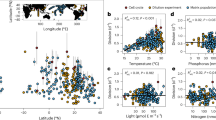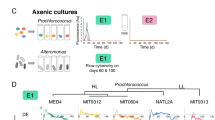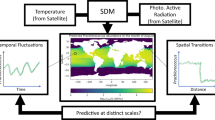Abstract
To better understand the temporal and spatial dynamics of Prochlorococcus populations, and how these populations co-vary with the physical environment, we followed monthly changes in the abundance of five ecotypes—two high-light adapted and three low-light adapted—over a 5-year period in coordination with the Bermuda Atlantic Time Series (BATS) and Hawaii Ocean Time-series (HOT) programs. Ecotype abundance displayed weak seasonal fluctuations at HOT and strong seasonal fluctuations at BATS. Furthermore, stable ‘layered’ depth distributions, where different Prochlorococcus ecotypes reached maximum abundance at different depths, were maintained consistently for 5 years at HOT. Layered distributions were also observed at BATS, although winter deep mixing events disrupted these patterns each year and produced large variations in ecotype abundance. Interestingly, the layered ecotype distributions were regularly reestablished each year after deep mixing subsided at BATS. In addition, Prochlorococcus ecotypes each responded differently to the strong seasonal changes in light, temperature and mixing at BATS, resulting in a reproducible annual succession of ecotype blooms. Patterns of ecotype abundance, in combination with physiological assays of cultured isolates, confirmed that the low-light adapted eNATL could be distinguished from other low-light adapted ecotypes based on its ability to withstand temporary exposure to high-intensity light, a characteristic stress of the surface mixed layer. Finally, total Prochlorococcus and Synechococcus dynamics were compared with similar time series data collected a decade earlier at each location. The two data sets were remarkably similar—testimony to the resilience of these complex dynamic systems on decadal time scales.
Similar content being viewed by others
Log in or create a free account to read this content
Gain free access to this article, as well as selected content from this journal and more on nature.com
or
References
Ahlgren NA, Rocap G, Chisholm SW . (2006). Measurement of Prochlorococcus ecotypes using real-time polymerase chain reaction reveals different abundances of genotypes with similar light physiologies. Environ Microbiol 8: 441–454.
Bertilsson S, Berglund O, Pullin MJ, Chisholm SW . (2005). Release of dissolved organic matter by Prochlorococcus. Vie Et Milieu-Life and Environment 55: 225–231.
Bibby TS, Gorbunov MY, Wyman KW, Falkowski PG . (2008). Photosynthetic community responses to upwelling in mesoscale eddies in the subtropical north atlantic and pacific oceans. Deep-Sea Res Part II-Top Stud Oceanogr 55: 1310–1320.
Bouman HA, Ulloa O, Scanlan DJ, Zwirglmaier K, Li WK, Platt T et al. (2006). Oceanographic basis of the global surface distribution of Prochlorococcus ecotypes. Science 312: 918–921.
Campbell L, Liu HB, Nolla HA, Vaulot D . (1997). Annual variability of phytoplankton and bacteria in the subtropical north pacific ocean at station ALOHA during the 1991–1994 ENSO event. Deep-Sea Res Part I-Oceanogr Res Pap 44: 167.
Campbell L, Nolla HA, Vaulot D . (1994). The importance of prochlorococcus to community structure in the central north pacific-ocean. Limnol Oceanogr 39: 954–961.
Carlson CA, Morris R, Parsons R, Treusch AH, Giovannoni SJ, Vergin K . (2009). Seasonal dynamics of SAR11 populations in the euphotic and mesopelagic zones of the northwestern Sargasso Sea. ISME J 3: 283–295.
Cavender-Bares KK, Karl DM, Chisholm SW . (2001). Nutrient gradients in the western north atlantic ocean: relationship to microbial community structure and comparison to patterns in the pacific ocean. Deep-Sea Res Part I-Oceanogr Res Pap 48: 2373–2395.
Clausen J, Keck DD, Hiesey WM . (1940). Experimental studies on the nature of species. I. Effects of varied environments on western North American plants. Carnegie Institute of Washington 520.
Cleveland WS . (1979). Robust locally weighted regression and smoothing scatterplots. J Am Stat Assoc 74: 829–836.
Coleman ML, Chisholm SW . (2007). Code and context: Prochlorococcus as a model for cross-scale biology. Trends Microbiol 15: 398–407.
Coleman ML, Sullivan MB, Martiny AC, Steglich C, Barry K, Delong EF et al. (2006). Genomic islands and the ecology and evolution of Prochlorococcus. Science 311: 1768–1770.
Cohan FM . (2001). Bacterial species and speciation. Systematic Biol 50: 513–524.
Cohan FM, Perry EB . (2007). A systematics for discovering the fundamental units of bacterial diversity. Curr Biol 17: R373–R386.
Corno G, Karl DM, Church MJ, Letelier RM, Lukas R, Bidigare RR et al. (2007). Impact of climate forcing on ecosystem processes in the North Pacific Subtropical Gyre. J Geophys Res 112: C04021, doi:10.1029/2006JC003730.
Doi T, Recktenwald A, Karaki Y, Kikuchi M, Morikawa K, Ikehara M et al. (1992). The role of the basic amino acid cluster and Glu-23 in pyrimidine dimer glycosylase activity of T4-endonuclease-V. Proc Natl Acad Sci USA 89: 9420–9424.
DeLong EF, Preston CM, Mincer T, Rich V, Hallam SJ, Frigaard NU et al. (2006). Community genomics among stratified microbial assemblages in the ocean's interior. Science 311: 496–503.
DuRand MD, Olson RJ, Chisholm SW . (2001). Phytoplankton population dynamics at the bermuda atlantic time-series station in the sargasso sea. Deep-Sea Res Part II-Top Stud Oceanogr 48: 1983–2003.
Frasier C, Alm EJ, Polz MF, Spratt BG, Hanage WP . (2009). The bacterial species challenge: making sense of genetic and ecological diversity. Science 323: 741–746.
Follows MJ, Dutkiewicz S, Grant S, Chisholm SW . (2007). Emergent biogeography of microbial communities in a model ocean. Science 315: 1843–1846.
Fuhrman JA, Hewson I, Schwalbach MS, Steele JA, Brown MV, Naeem S . (2006). Annually reoccurring bacterial communities are predictable from ocean conditions. Proc Natl Acad Sci USA 103: 13104–13109.
Goosen N, Moolenaar GF . (2008). Repair of UV damage in bacteria. DNA Repair 7: 353–379.
Havaux M, Guedeney G, He QF, Grossman AR . (2003). Elimination of high-light-inducible polypeptides related to eukaryotic chlorophyll a/b-binding proteins results in aberrant photoacclimation in Synechocystis PCC6803. Biochimica Et Biophysica Acta-Bioenergetics 1557: 21–33.
He QF, Dolganov N, Bjorkman O, Grossman AR . (2001). The high light-inducible polypeptides in Synechocystis PCC6803 - Expression and function in high light. J Biol Chem 276: 306–314.
Johnson ZI, Zinser ER, Coe A, McNulty NP, Woodward EMS, Chisholm SW . (2006). Niche partitioning among Prochlorococcus ecotypes along ocean-scale environmental gradients. Science 311: 1737–1740.
Karl DM, Letelier R, Hebel D, Tupas L, Dore J, Christian J et al. (1995). Ecosystem changes in the north pacific subtropical gyre attributed to the 1991–92 El-Nino. Nature 373: 230–234.
Karl DM, Lukas R . (1996). The hawaii ocean time-series (HOT) program: background, rationale and field implementation. Deep-Sea Res Part II-Top Stud Oceanogr 43: 129–156.
Kettler GC, Martiny AC, Huang K, Zucker J, Coleman ML, Rodrigue S et al. (2007). Patterns and implications of gene gain and loss in the evolution of Prochlorococcus. Plos Genetics 3: 2515–2528.
Legendre P, Legendre L (eds). (1998). Ecological data series. In: Numerical Ecology: Second English Addition. Elsevier Science BV: Amsterdam, pp 637–691.
Letelier RM, Karl DM, Abbott MR, Flament P, Freilich M, Lukas R et al. (2000). Role of late winter mesoscale events in the biogeochemical variability of the upper water column of the north pacific subtropical gyre. J Geophysical Res-Oceans 105: 28723–28739.
Ludwig W, Strunk O, Westram R, Richter L, Meier H, Yadhukumar Buchner A et al. (2004). ARB: a software environment for sequence data. Nucleic Acids Res 32: 1363–1371.
Malmstrom RR, Cottrell MT, Elifantz H, Kirchman DL . (2005). Biomass production and dissolved organic matter assimilation by SAR11 bacteria in the northwest atlantic ocean. Appl Environ Microbiol 71: 2979–2986.
Malmstrom RR, Kiene RP, Cottrell MT, Kirchman DL . (2004). Contribution of SAR11 bacteria to dissolved dimethylsulfoniopropionate and amino acid uptake in the North Atlantic Ocean. Appl Environ Microbiol 70: 4129–4135.
Martiny AC, Coleman ML, Chisholm SW . (2006). Phosphate acquisition genes in Prochlorococcus ecotypes: Evidence for genome-wide adaptation. Proc Natl Acad Sci USA 103: 12552–12557.
Martiny AC, Kathuria S, Berube PM . (2009a). Widespread metabolic potential for nitrite and nitrate assimilation among Prochlorococcus ecotypes. Proc Natl Acad Sci USA 106: 10787–10792.
Martiny AC, Tai APK, Veneziano D, Primeau F, Chisholm SW . (2009b). Taxonomic resolution, ecotypes and the biogeography of Prochlorococcus. Environ Microbiol 11: 823–832.
Michelou VK, Cottrell MT, Kirchman DL . (2007). Light-stimulated bacterial production and amino acid assimilation by cyanobacteria and other microbes in the north atlantic ocean. Appl Environ Microbiol 73: 5539–5546.
Moore LR, Chisholm SW . (1999). Photophysiology of the marine cyanobacterium Prochlorococcus: ecotypic differences among cultured isolates. Limnol Oceanogr 44: 628–638.
Moore LR, Coe A, Zinser ER, Saito MA, Sullivan MB, Lindell D et al. (2007). Culturing the marine cyanobacterium Prochlorococcus. Limnol Oceanog 5: 353–362.
Moore LR, Ostrowski M, Scanlan DJ, Feren K, Sweetsir T . (2005). Ecotypic variation in phosphorus acquisition mechanisms within marine picocyanobacteria. Aquat Microb Ecol 39: 257–269.
Moore LR, Post AF, Rocap G, Chisholm SW . (2002). Utilization of different nitrogen sources by the marine cyanobacteria Prochlorococcus and Synechococcus. Limnol Oceanogr 47: 989–996.
Moore LR, Rocap G, Chisholm SW . (1998). Physiology and molecular phylogeny of coexisting Prochlorococcus ecotypes. Nature 393: 464–467.
Morris RM, Rappé MS, Connon SA, Vergin KL, Siebold WA, Carlson CA et al. (2002). SAR11 clade dominates ocean surface bacterioplankton communities. Nature 420: 806–810.
Olson RJ, Chisholm SW, Zettler ER, Altabet MA, Dusenberry JA . (1990a). Spatial and temporal distributions of prochlorophyte picoplankton in the north-atlantic ocean. Deep-Sea Res Part a-Oceanographic Res Papers 37: 1033–1051.
Olson RJ, Chisholm SW, Zettler ER, Armbrust EV . (1990b). Pigments, size, and distribution of synechococcus in the north-atlantic and pacific oceans. Limnol Oceanogr 35: 45–58.
Osburne MS, Holmbeck BM, Frias-Lopez J, Steen R, Huang K, Kelly L et al. (2010). UV hyper-resistance in Prochlorococcus MED4 results from a single base pair deletion just upstream of an operon encoding nudix hydrolase and photolyase. Environ Microbiol Published Online: 23 March 2010; DOI: 10.1111/j.1462-2920.2010.02203.x.
Partensky F, Garczarek L . (2010). Prochlorococcus: advantages and limits of minimalism. Annu Rev Marin Sci Vol. 2 305–331.
Partensky F, Hess WR, Vaulot D . (1999). Prochlorococcus:a marine photosynthetic prokaryote of global significance. Microbiol Mol Biol Rev 63: 106.
Promnares K, Komenda J, Bumba L, Nebesarova J, Vacha F, Tichy M . (2006). Cyanobacterial small chlorophyll-binding protein ScpD (HliB) is located on the periphery of photosystem II in the vicinity of PsbH and CP47 subunits. J Biol Chem 281: 32705–32713.
Ramirez-Flandes S, Ulloa O . (2008). Bosque: integrated phylogenetic analysis software. Bioinformatics 24: 2539–2541.
Rocap G, Distel DL, Waterbury JB, Chisholm SW . (2002). Resolution of Prochlorococcus and Synechococcus ecotypes by using 16S-23S ribosomal DNA internal transcribed spacer sequences. Appl Environ Microbiol 68: 1180–1191.
Rocap G, Larimer FW, Lamerdin J, Malfatti S, Chain P, Ahlgren NA et al. (2003). Genome divergence in two Prochlorococcus ecotypes reflects oceanic niche differentiation. Nature 424: 1042–1047.
Sancar GB . (2000). Enzymatic photoreactivation: 50 years and counting. Mutation Res-Fundamental Mol Mechanisms Mutagenesis 451: 25–37.
Six C, Finkel ZV, Irwin AJ, Campbell DA . (2009). Light variability illuminates niche-partitioning among marine picocyanobacteria. PLoS ONE 2: e1341.
Stackebrandt E, Goebel BM . (1994). Taxonomic note: a place for DNA:DNA reassociation and 16S rRNA sequence analysis in the present species definition in bacteriology. Int J Syst Bacteriol 44: 846–849.
Steinberg DK, Carlson CA, Bates NR, Johnson RJ, Michaels AF, Knap AH . (2001). Overview of the US JGOFS Bermuda atlantic time-series study (BATS): a decade-scale look at ocean biology and biogeochemistry. Deep-Sea Res Part II-Top Stud Oceanogr 48: 1405–1447.
Treusch AH, Vergin KL, Finlay LA, Donatz MG, Burton RM, Carlson CA et al. (2009). Seasonality and vertical structure of microbial communities in an ocean gyre. ISME J 3: 1148–1163.
Turesson G . (1922). Species and the variety as ecological units. Hereditas 3: 100–113.
Venter JC, Remington K, Heidelberg JF, Halpern AL, Rusch D, Eisen JA et al. (2004). Environmental genome shotgun sequencing of the sargasso sea. Science 304: 66–74.
Vila-Costa M, Simo R, Harada H, Gasol JM, Slezak D, Kiene RP . (2006). Dimethylsulfoniopropionate uptake by marine phytoplankton. Science 314: 652–654.
Ward DM, Bateson MM, Ferris MJ, Kühl M, Wieland A, Koeppel A et al. (2006). Cyanobacterial ecotypes in the microbial mat community of mushroom spring (yellowstone national park, wyoming) as species-like units linking microbial community composition, structure and function. Philos Trans R Soc London (Biol) 361: 1997–2008.
West NJ, Scanlan DJ . (1999). Niche-partitioning of Prochlorococcus populations in a stratified water column in the eastern North Atlantic Ocean. Appl Environ Microbiol 65: 2585–2591.
West NJ, Schönhuber WA, Fuller NJ, Amann RI, Rippka R, Post AF et al. (2001). Closely related Prochlorococcus genotypes show remarkably different depth distributions in two oceanic regions as revealed by in situ hybridization using 16S rRNA-targeted oligonucleotides. Microbiology 147: 1731–1744.
White AE, Spitz YH, Letelier RM . (2007). What factors are driving summer phytoplankton blooms in the North Pacific Subtropical Gyre? J Geophys Res 112: C12006, doi:10.1029/2007JC004129.
Wu JF, Sunda W, Boyle EA, Karl DM . (2000). Phosphate depletion in the western north atlantic ocean. Science 289: 759–762.
Yao D, Kieselbach T, Komenda J, Promnares K, Prieto MA, Tichy M et al. (2007). Localization of the small CAB-like proteins in photosystem II. J Biol Chem 282: 267–276.
Zinser ER, Coe A, Johnson ZI, Martiny AC, Fuller NJ, Scanlan DJ et al. (2006). Prochlorococcus ecotype abundances in the North Atlantic Ocean as revealed by an improved quantitative PCR method. Appl Environ Microbiol 72: 723–732.
Zinser ER, Johnson ZI, Coe A, Karaca E, Veneziano D, Chisholm SW . (2007). Influence of light and temperature on Prochlorococcus ecotype distributions in the Atlantic Ocean. Limnol Oceanogr 52: 2205–2220.
Zubkov MV, Fuchs BM, Tarran GA, Burkill PH, Amann R . (2003). High rate of uptake of organic nitrogen compounds by Prochlorococcus cyanobacteria as a key to their dominance in oligotrophic oceanic waters. Appl Environ Microbiol 69: 1299–1304.
Zwirglmaier K, Heywood JL, Chamberlain K, Woodward EMS, Zubkov MV, Scanlan DJ . (2007). Basin-scale distribution patters of picocyanobacterial lineages in the Atlantic Ocean. Environ Microbiol 9: 1278–1290.
Acknowledgements
We thank Michael Lomas and the BATS team for sample collection at Bermuda, and David Karl, Matthew Church, and the HOT team for sample collection at Hawaii. We also thank Angel White and Ricardo Letelier for assistance with deriving solar flux data and attenuation coefficients. Norm Nelson and David Court generously provided light data from the Bermuda Bio Optics Program. We thank Daniele Veneziano for advice on statistical analysis. This work was funded by grants from the National Science Foundation, NSF STC Center for Microbial Oceanography: Research and Education, and the Gordon and Betty Moore Foundation.
Author information
Authors and Affiliations
Corresponding author
Additional information
Supplementary Information accompanies the paper on The ISME Journal website
Supplementary information
Rights and permissions
About this article
Cite this article
Malmstrom, R., Coe, A., Kettler, G. et al. Temporal dynamics of Prochlorococcus ecotypes in the Atlantic and Pacific oceans. ISME J 4, 1252–1264 (2010). https://doi.org/10.1038/ismej.2010.60
Received:
Revised:
Accepted:
Published:
Issue date:
DOI: https://doi.org/10.1038/ismej.2010.60
Keywords
This article is cited by
-
Climate variability effects on autotrophic picophytoplankton in the southern Gulf of California
Hydrobiologia (2024)
-
Phytoplankton community responses to the combined effects of internal waves and anticyclonic eddies shed from the Kuroshio intrusion
Ocean Dynamics (2024)
-
Draft genomes of three closely related low light-adapted Prochlorococcus
BMC Genomic Data (2023)
-
Phototroph-heterotroph interactions during growth and long-term starvation across Prochlorococcus and Alteromonas diversity
The ISME Journal (2023)
-
Synechococcus nitrogen gene loss in iron-limited ocean regions
ISME Communications (2023)



